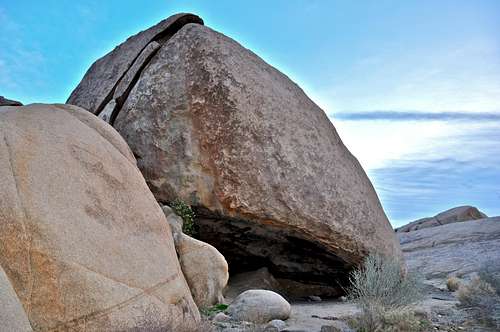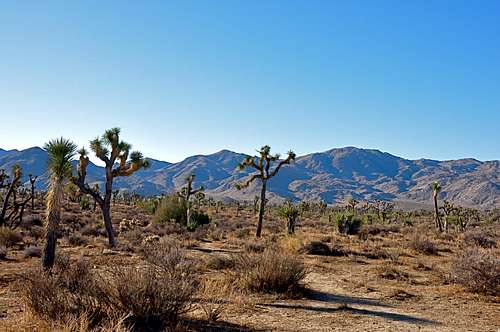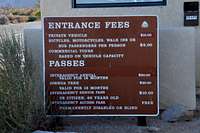-
 5111 Hits
5111 Hits
-
 87.31% Score
87.31% Score
-
 24 Votes
24 Votes
|
|
Mountain/Rock |
|---|---|
|
|
34.00941°N / 116.05554°W |
|
|
Riverside |
|
|
Trad Climbing |
|
|
Spring, Summer, Fall, Winter |
|
|
4300 ft / 1311 m |
|
|
Overview
This page is about a collection of rocks and boulders surrounding the Split Rocks parking lot in Joshua Tree National Park, California.
The name Split Rocks originated from a large boulder to the north of the parking lot that split in a nearly perfect manner. There are, however, many more rocks, bigger and smaller, in and around this parking lot. Most visitors to Joshua Tree enter the park from the western entrance. There is a lot to see driving down the Park Boulevard, the main artery through the park. Split Rocks parking area is the last point of interest before back or continuing toward the east entrance. Yet, it's not unusual to see the parking lot full of visitors during a weekend.
There are a number of boulders of different sizes and you often see children playing on the smaller, low angle ones. There are also a number of much more challenging boulders requiring skilled climbers to tackle. The major attraction, however, are the rock formations that offer mostly moderate level technical climbing. Most climbers seeking a little more solitude head southwest toward Isles In The Sky, or north toward Future Games Rock. As is obvious from the title to this page, this is, after all, a parking lot and it will not provide a secluded climbing experience.
Select Routes
The earliest known technical route was established in the late 1950s and was done on the most prominent large boulder to the north of the parking lot. The name of this route is "Split Rocks," rated 5.8. During the following two decades two more routes were established on the nearby boulders and blocks of rocks. These two routes are a hand crack called "Big Boy," rated 5.9 and an off-width named "In And Out," also rated 5.9. Considering the large number of great crack climbs all over the park, it should come as no surprise that these cracks don't see many ascents.
Aside from the large boulders and blocks of rocks, there is a convoluted formation named "Split Dome" directly to the east of the parking lot. True to its name, Split Dome has a prominent crack that splits this dome into two. There are a number of crack and face routes on this dome and the adjoining large blocks of rocks to the south of it. In the more recent years a new bolted route, about 5.8, has appeared to the left of Split Dome. This unknown short route follows a series of shallow potholes to its own anchor. If you have some information about this route, please add it to the Additions & Corrections of this page.
List of select routes
select routes of Split Rocks Parking Lot area | |
| A | In And Out, 5.9, Off-Width, big pro |
| B | Big Boy, 5.9, hand crack |
| C | Unknown, 5.8, bolts |
| D | Worthy of It, 5.8, crack, standard pro |
| E | Environmental-Oil President, 10c, bolts and gear |
Getting There
From the western entrance to Joshua Tree National Park drive on Park Boulevard, formerly known as Quail Springs Road, for about nine miles to a major rock formation called “Intersection Rock.” Intersection Rock is a major landmark on the north side of Quail Springs Road with ample parking for visitors and climbers alike. This rock, true to its name, sit at the cross roads to “Hidden Valley Campground”, Barker Dam Road and the road to “Day use and picnic” area. From Intersection Rock drive another 9.6 miles on Park Boulevard to it’s intersection with Split Rocks Road. Turn left and drive to the end of the road. This is a “Day Use Area. There is a bathroom just to the south of the parking lot.
Camping, Noise Considerations, Environmental Concerns,
Please tread lightly. The Access Fund has gone to great lengths posting trail marker for approaches to many of the more popular crags. Do your best to stay on these trails, and where you are forced to use a different path, choose the ones that rain can mend in time. Drainages make for good trails where there are no established trails.
Avoid stepping on native and fragile plants, and do not feed the coyotes. Coyotes are very much used to people and often hang around picnic areas and camp grounds in hopes of getting a hand out. It’s better to let them live their natural life.
Camping
There are nine campgrounds in Joshua Tree National Park. At the entrance to the park you are always asked if you would care to have a map and a brochure. The brochure will have plenty of information on the campgrounds and the map will guide you to many of the pleasant hikes throughout the park. You may even get the latest information as to availability of campsites. During the peak season (mid winter through spring) finding a campsite may become a major task. It is highly recommended to use the following link to get more information in advance.
Joshua Tree Camping
Noise considerations
When you are camping with friends and sitting around the fire, it is easy to forget that there are other people trying to sleep in the nearby campsites. It is important to put yourself in their shoes. Keep the noise and music to a minimum and certainly not too much past 10 p.m. Your neighbors will smile at you in the morning instead of giving you dirty looks.













